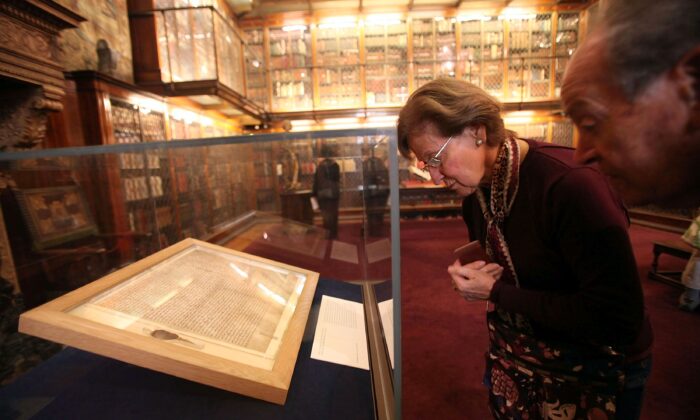Commentary
Both Canada and the United States inherited the right to bear arms found in the
English Magna Carta of 1689, but, despite this
common heritage, their paths diverged widely since their founding. While the American
Constitution protects the right to bear arms, Canadian elites effectively surrendered this basic right. Canadian elites gradually abandoned their duty to uphold the basic rights outlined in the Magna Carta, despite widespread popular support for the right to bear arms. This summary is drawn from a series of articles published in the
Dorchester Review.
Defending oneself from physical attack is a natural human right. Major world religions (
Judaism,
Christianity, both
Catholic and
Protestant, and
Asian religions) hold that it can be moral to use violence to defend oneself (or one’s family), even if the attacker is killed doing so. But to defend oneself effectively, one needs the right tools. Firearms allow smaller individuals, such as women, to protect themselves from attackers who may be bigger and stronger.
According to public opinion
polls, almost three-quarters (72 percent) of Americans who own firearms say their firearms are for protection. That’s not just bravado. In the past 10 years,
more than one-third (35 percent) of all active shooting incidents in the United States were stopped by legally armed citizens. For example, in Phoenix in 2023, an
armed citizen stopped an angry individual who had shot four people and threatened others in Cielo Vista Mall. Armed Americans protect their communities as well as their families.
In the United States,
the Second Amendment protects the right to bear arms, so both men and women can legally carry a firearm for personal protection. But in Canada, this basic human right is bitterly contested. Despite
strong popular commitment to the right to bear arms for protection, the government, backed by the Laurentian elite, opposes this basic human right.
Canada’s
founders broadly agreed that residents of British North America, as British subjects, had inherited the right to bear arms from the Magna Carta, but they also worried about the “questionable loyalty” of various groups. Canada’s first prime minister,
Sir John A Macdonald, strongly opposed gun laws that would disarm vulnerable people, such as indigenous Canadians or Irish canal workers. The first serious restrictions on handguns had to wait until the Liberals won control of Parliament in 1874.
From the first, despite strong public support for this right, bearing arms for personal protection rested upon official discretion, eventually evolving into police permits. The government’s intention was to facilitate arms for the “better classes,” while discriminating against whoever the elite considered “suspect,” such as new immigrants, and later, from “Reds” or organized labour, and still later, from suspected terrorists.
The founders of Canada were concerned about order and stability so they created a government that the political elites could control; the long-term effect was that legislation is much less likely to reflect popular opinion than is the case in the United States. Recent Canadian history is replete with examples of controversial legislation enacted by the progressive elites in Ottawa with little regard for popular support, for example, the
metric system, the
Meech Lake Accord, and the carbon tax.
Canada has a long history of
gun-control measures that fail to reduce criminal violence, but these repeated failures merely inspire
ever more restrictive legislation. Politicians often feel they “must do something” when spooked by inflamed media reports of criminal violence. Each new proposed restriction on firearms is justified in public by claiming it will reduce “gun violence,” but the
true goals of the government are often quite different. As the government increasingly lost trust in the general public,
everyone eventually became “suspect,” and the fear of political unrest continued to grow.
The dogmas that are widespread among urban elites are often foreign to the general public. Most Canadians believe there is a natural right to use a firearm for personal protection. Support for this claim comes from a variety of sources.
Professional public opinion surveys find broad support for such a right. A majority (58 percent) agree that “Canadian Citizens should have the right to own a firearm.” Almost two-thirds of respondents (60 percent) say they would be willing to use a firearm if their family were threatened with death or serious injury by an aggressor.
Even supporters of gun control say they would be
willing to use a firearm to defend their family if push came to shove. Almost two-thirds of Canadian respondents (60 percent) say they would be willing to use a firearm if their family were threatened with death or serious injury by an aggressor.
Defending oneself against physical attack is a natural right.
Canadians report using firearms to protect themselves or their family from human threats between 19,000 and 37,500 times per year, and if wild animal attacks are considered, between 60,000 and 80,000 times per year, according to professional surveys. These survey results do not include the use of firearms by police or other officials to protect parliamentarians or the general public.
After the progressives captured the administrative state in the late 1960s, they soon demonstrated their contempt for traditional Canadian virtues such as
armed self-defence.
They ran their campaign on transforming Canada, and they succeeded. Despite widespread public support for the right to bear arms, Canada continued to slide down a slippery slope. In the 21st century, this authority resulted in the prohibition (and eventual confiscation) of all handguns and many popular semi-automatic rifles.
The divide persists between the progressive establishment and resilient Canadians who uphold their belief in the right to bear arms.
(Views expressed in this article are the author’s opinions and do not necessarily represent the views of The Epoch Times.)
Source link






